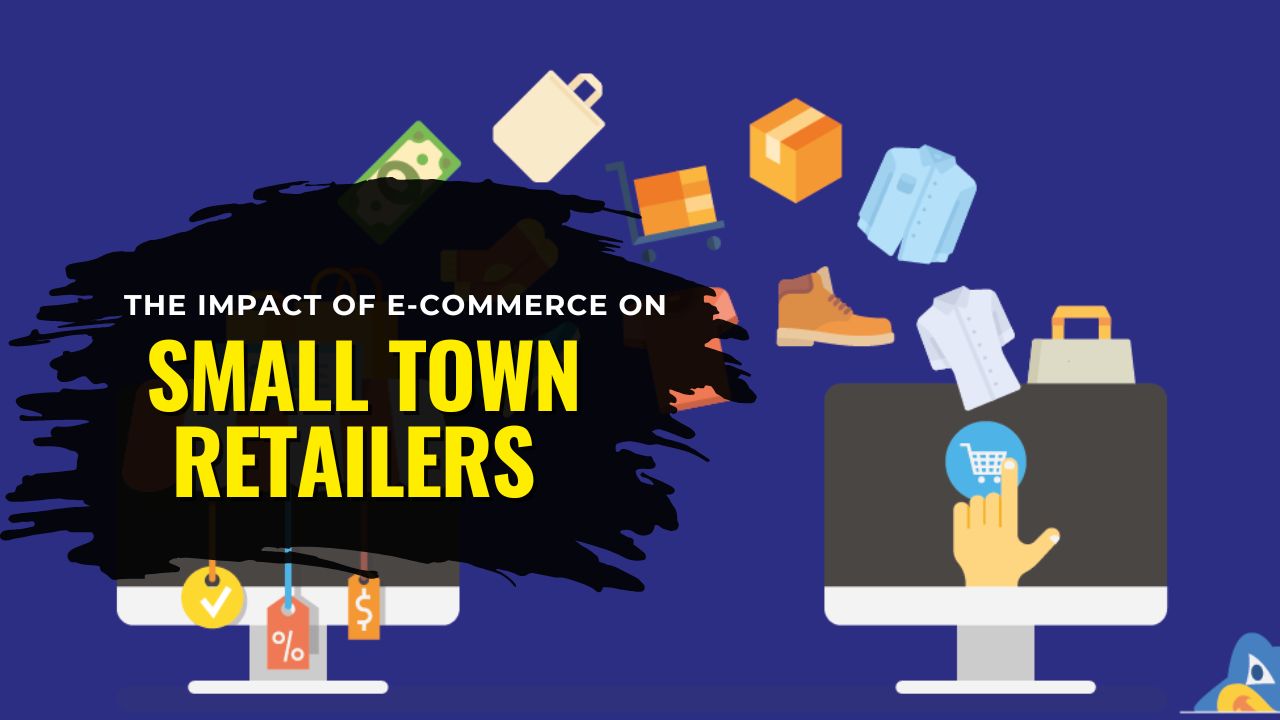Small towns are living through a retail reset. E-commerce is no longer a side project or a seasonal test—it’s the second front door to every shop on Main Street.
The mix of online discovery, local pickup, and fast shipping has permanently changed how customers browse, compare prices, and decide where to spend.
For small-town retailers, the opportunity is to turn local trust into regional (or national) reach—without losing the community touch that makes them special.
The new customer journey (and where small towns can win)
Once, discovery started at a window display or a newspaper ad. Today, it starts on a phone. Shoppers search, see a short video, tap into reviews, add to cart, and choose BOPIS (Buy Online, Pick Up In-Store) or home delivery. That shift favors retailers who:
- Keep a mobile-first product catalog with clear titles, photos, and real-time availability.
- Offer BOPIS and curbside so customers save on shipping and get items same-day.
- Use local SEO and up-to-date Google Business Profiles so “near me” searches actually find them.
- Turn social followers into email/SMS subscribers to drive repeat purchases.
What’s changed on Main Street
- Geography matters less. A boutique on a quiet square can sell nationwide 24/7 while still anchoring local foot traffic.
- Inventory works harder. Ship-from-store turns back rooms into micro-fulfillment centers; BOPIS sparks impulse add-ons at pickup.
- Marketing blends performance and place. Social commerce attracts first-time buyers; farmer’s market pop-ups and in-store events build loyalty.
- Margins hinge on the last mile. Carrier choice, packaging weight, and delivery promises directly affect profitability—especially beyond metro areas.
- AI-driven discovery is rising. Clean, structured data (titles, attributes, availability) helps products surface in AI shopping assistants and search results.
The upside for small-town retailers
- Bigger addressable market: Online extends reach beyond county lines without opening a new location.
- Higher stock turns: Omnichannel selling reduces seasonal markdowns because inventory is visible to more buyers.
- Better customer data: Web analytics, email, and loyalty programs reveal what shoppers want—right down to size, color, and day-of-week behavior.
- Defensible local moat: Personal service, community roots, and fast pickup create value e-commerce giants struggle to match in rural areas.
The hard parts (and how to fix them)
- Shipping costs: Use multi-carrier rate shopping, free-shipping thresholds aligned to your average order value, and flat-rate packaging.
- Returns: Encourage exchanges and store credit; add fit guides and live chat to reduce misbuys.
- Operational strain: Batch printing labels, clear order cut-off times, and simple in-store pickup flows keep small teams sane.
- Connectivity gaps: Keep a backup hotspot and offline-capable POS so sales don’t stop when the internet blinks.
Numbers every small-town shop should track
- Online share of total sales: Aim for steady growth (e.g., +2–4 percentage points per year) while maintaining strong in-store traffic.
- BOPIS adoption: Track what percent of orders are pickup—these typically have lower fulfillment costs and higher add-on rates.
- Contribution margin by channel: After shipping, packaging, ads, and returns, which orders make money? Adjust promos accordingly.
- Customer acquisition cost (CAC) vs. lifetime value (LTV): Keep CAC/LTV under control by building owned lists (email/SMS) and loyalty programs.
- On-time delivery & pickup SLAs: Late orders crush reviews in smaller communities—monitor daily.
Snapshot – E-Commerce Impact & Playbook for Small-Town Retailers
| Area | What’s Changing | Risks if Ignored | Action for 2025 | KPI to Watch |
|---|---|---|---|---|
| Discovery | Shoppers find products via local SEO, social, and AI-driven recommendations | Low visibility; traffic goes to chains | Optimize Google Business Profile, titles/attributes, and local keywords | Organic clicks, store impressions |
| Fulfillment | BOPIS/curbside plus ship-from-store | High shipping spend; slow delivery | Offer pickup windows, route shipments by cheapest on-time carrier | % BOPIS, ship cost/order |
| Pricing/Margins | Dynamic promos; free-shipping thresholds | Margin erosion | Tie thresholds to AOV; audit packaging/DIM weights quarterly | Contribution margin/order |
| Customer Data | Email/SMS beats pure social | Algorithm dependence | Grow owned lists, segment by category & recency | Repeat purchase rate |
| Operations | Small teams need clarity and automation | Burnout; order errors | Clear SOPs, batch picks/labels, automated notifications | On-time rate; order touches |
| Assortment | Depth online > breadth in store | Stockouts; slow turns | Show all variants online; highlight “pickup today” SKUs | Sell-through; size/color coverage |
| Community | Local loyalty still decisive | Race to the bottom on price | Events, bundles, locals-only deals | Event conversion; bundle attach |
Practical playbook (step-by-step)
1) Nail the online storefront
Keep product names clear and searchable (brand, item, key attribute). Use 4–6 images per item and a short, skimmable description. Mark items “Ready for Pickup Today” when they’re physically in stock.
2) Turn on BOPIS and curbside
Promote pickup prominently on product pages and at checkout. Offer same-day pickup for in-stock items and next-day for transfers from your back room or nearby sister store.
3) Treat shipping like a P&L
Install software that compares USPS/UPS/FedEx rates automatically. Set free-shipping just above your AOV (for example, if AOV is $48, test free at $59 or $69). Use flat-rate boxes for heavy, compact goods.
4) Build a loyalty loop
Offer points or stamp cards that reward pickup and in-store add-ons (e.g., “Buy online, pick up twice—get 10% off your next visit”). Send a post-pickup message suggesting complementary items.
5) Use content to sell
Short try-on clips, unboxings, and “what just arrived” videos outperform static posts. Add QR codes at your register that join shoppers to your list. Schedule heavier content during holiday weeks and local festivals.
6) Prepare for patchy internet
Keep an offline-capable POS, a backup hotspot, and a simple contingency plan for taking payments or issuing pickup codes when service dips.
7) Measure and iterate weekly
Review: (a) top traffic sources, (b) on-time pickup, (c) shipping cost per order, (d) returns by SKU/size, and (e) email/SMS growth. Trim what isn’t working; double down on what is.
Mini case examples (typical small-town wins)
- Apparel boutique: Adds BOPIS and “try-on at pickup.” Result: higher foot traffic on Fridays and a consistent add-on of accessories at the counter.
- Hardware store: Lists top 300 consumables online; offers Saturday morning pickup. Result: contractors pre-order, leading to larger baskets and fewer stockouts.
- Specialty foods: Switches to flat-rate for heavy items and free shipping above a smart threshold. Result: steadier margins and fewer abandoned carts.
- Gift shop: Creates “locals-only” drops released online at 9 a.m., pickup after school. Result: repeat purchase cadence and more reviews.
E-commerce has permanently expanded the playing field for small-town retailers.
The winners aren’t the biggest—they’re the most adaptable. By pairing local trust with digital reach, enabling BOPIS to control costs, and treating shipping, data, and loyalty as core disciplines, Main Street can thrive against national competitors.
The result is a resilient, hybrid model: online for discovery and reach, in-store for service and community. When small-town shops execute this playbook, they don’t just survive the digital era—they set the pace for it.
FAQs
What’s the best first step if I’ve never sold online?
Start with a simple, mobile-friendly catalog of your top sellers and enable BOPIS. It proves demand quickly, keeps fulfillment costs down, and brings customers into the store for add-on purchases.
How do I compete on price with big online retailers?
Don’t race to the bottom. Compete on speed of pickup, expert advice, bundles (e.g., “starter kit” discounts), and local perks like repair, alterations, or free gift wrapping. These add value that pure price can’t touch.
What if shipping costs make certain items unprofitable?
Tag them “pickup-only” online, or bundle them with complementary items to raise order value. Test alternative packaging, compare carriers regularly, and use flat-rate options where they win.

